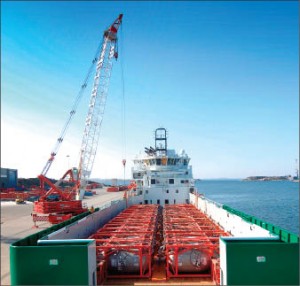HSE Corner: Pneumatic conveyance of drill cuttings may offer solution for sensitive, strictly regulated environments
By Jan Thore Eia, M-I SWACO

As environmental regulations get more stringent around the world, oil companies, drilling contractors and the service industry are working together to reduce chemical exposure, improve rig safety and reduce the risk of pollution while drilling increasingly complex wells.
When performing top hole drilling with seawater and natural clays in highly regulated areas, the formation cuttings are often discharged directly onto the seabed to minimize impact to the environment, rather than bringing it to surface for collection and transportation back to shore. This will relocate these natural materials and add air pollution, and it may not be the best solution if, for example, vulnerable seabed coral reefs are present.
The technology for removing cuttings from these sensitive areas for disposal in deeper and less vulnerable waters or transportation back to land is available today. Although new high-performance water-base drilling fluid technologies are being developed, technical challenges may require oil- or synthetic-base fluids in some instances. To meet environmental requirements, these fluids must always be used with absolute care.
The CLEANCUT system for pneumatic conveyance of drilled cuttings is a totally enclosed cuttings-handling system that handles all cuttings from water-base and oil-base systems, offshore and onshore, using only clean and pressurized air. Nearly 900 well sections have been successfully completed with the system around the world, including in North and South America, Europe, Russia, the Mediterranean, Middle East, Africa and Asia Pacific.
The system is totally enclosed and can be automated to reduce personnel onboard. It almost eliminates crane lifts, simplifies the logistics and minimizes deck space requirements. The cuttings are transferred via an overboard hose to the transport vessel using clean, compressed air. A safety coupling can allow a boat to pull away from the rig with no risk of equipment damage or spill if weather conditions get rough. The system will also move cuttings from the collection point to any location on the rig, platform or supply vessel for treatment or storage.
FIELD USE: BRAZIL
Brazil’s environmental legislation requires zero discharge of water-base drilling fluids in shallow waters less than 195 ft (60 m). To enable the development of a gas field offshore Brazil, this cuttings containment system was installed. A vessel that was also equipped with the system was able to sail to deep waters where cuttings discharge is permitted, then discharge the cuttings.
The system on the rigs ensured that drilling could proceed uninterrupted while the containment vessel was away from the drilling site. The Brazilian Institute of Environmental and Renewable Natural Resources (IBAMA) maintained a compliance engineer onboard at all times, and full compliance was achieved. This opened the door to drilling in other restricted areas of Brazil.
The cuttings containment system was also used in a secondary application to receive water-base liquid mud and tank settlements from the rig’s sand traps and to contain residues from the mud pit cleaning. The system also contained interfaces and mud spacers during displacements, proving that it is capable of handling liquid volumes as well as drill cuttings.
FIELD USE: RUSSIA
In another project where the focus was on meeting stringent QHSE goals and mandatory Russian regulatory compliance criteria in an extremely sensitive marine fishing environment, an operator was required to monitor the discharge of all cuttings and drilling waste offshore while drilling an exploration well. The cuttings containment system allowed the operator to drill the well with full compliance of the zero-discharge policy.
The results were zero lost-time incidents, zero spills, zero accidents and 100% compliance with safety initiatives.
AUTOMATION AVAILABLE
The system also offers modular combinations and flexibility, with add-on technology combinations available to make the system automated with full weight control, automatic cleaning, winterization and complete integration with cuttings dryers, offshore thermal treatment and cutting slurrification and injection.
Cuttings conditions and drilling rates vary, and most process systems require continuous feed for optimum operating conditions. They can be buffered with the transport and storage capability that this system offers.
Offshore thermal treatment of cuttings to reduce environmental impact and comply with discharge regulations has a slightly lower process rate than the high ROP drilling dictates. This cutting containment system buffers the drilling operation and temporarily stores cuttings to enable the thermal process to run continuously at its maximum rate, therefore enabling drilling to continue at its maximum rate.
Wet cuttings can be stored prior to the thermal process, and dry cuttings can be stored after treatment, should that be required for transport to other disposal site.
Wet cuttings storage can also be buffered during cuttings reinjection operations if extra capacity is required. There’s also system redundancy for maintenance or shut-down. ISO-pumps enable finished slurry storage if the injection pump or injection well are unavailable for shorter periods.
By using clean, pressurized air to transport cuttings, fluids or other materials, this system allows operators to safely and efficiently handle drilled cuttings and comply with environmental regulations.
CLEANCUT is a mark of M-I, LLC.
Jan Thore Eia is global business line manager within cuttings handling & transportation in M-I SWACO. He has over 24 years of industry experience in technical engineering, management and business development from mainly Scandinavia but also Europe, Caspian, North Africa, the US and South America. He graduated as B.Sc. in Petroleum Engineering from University in Stavanger 1983. He joined M-I in 1985 as a drilling fluids engineer and has been operations manager for both M-I and Swaco in Scandinavia. He holds a Master of Management degree from Oslo Business School 2006.




